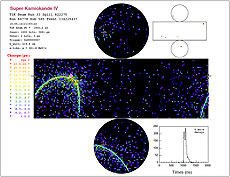T2K result indicates electron neutrino appearance

The T2K experiment has detected six candidate events for oscillations of muon neutrinos into electron neutrinos. In this graphic, each colored dot shows the light detected when an electron neutrino hit a water molecule inside the Super-Kamiokande detector and created an electron that led to the emission of Cerenkov light.

The T2K experiment sends a beam of muon neutrinos from the J-PARC facility 295 kilometers through the earth to the Super-Kamiokande neutrino detector. A near detector measures the purity of the muon neutrino beam, and the Super-K detector looks for the appearance of electron neutrinos due to neutrino oscillations.
The T2K experiment in Japan has observed six particle events that indicate the oscillation of muon neutrinos into electron neutrinos, a long-sought signal that allows scientists to better understand a phenomenon known as neutrino oscillations. For a long time scientists have suspected that the three known types of neutrinos can morph into each other. Several experiments previously found neutrinos to disappear.
The T2K experiment is the first experiment to report candidate events for the appearance of electron neutrinos in a muon neutrino beam. The experiment analyses a muon neutrino beam that travels 295 kilometers through the earth from the Japan Proton Accelerator Research Complex (J-PARC) to the 50,000-ton Super-Kamiokande neutrino detector.
Based on the analysis of the data collected by the T2K experiment between January 2010 and March 11, 2011, when the experiment was interrupted due to the magnitude 9 earthquake in eastern Japan, scientists found 88 neutrino events that were detected by the Super-Kamiokande detector. Among these 88 events, they identified six candidate events as electron neutrino interactions.
"Congratulations to our Japanese colleagues for their excellent work," said Fermilab's Rob Plunkett, co-spokesperson for the MINOS neutrino experiment. "This is a major accomplishment of the T2K program."
The T2K result indicates that the last unknown neutrino mixing angle, called theta-13, is non-zero, with a significance of 2.5 sigma. If theta-13 were zero, the T2K experiment should only have found one or two electron neutrino events.
The result is good news for the Fermilab neutrino program.
"This is a great result for NOvA," said Mark Messier, of Indiana University and co-spokesperson of the NOvA neutrino experiment under construction at Fermilab. "It means that NOvA will be able to solve the question of the neutrino mass ordering, a question that no other neutrino experiment in operation or under construction can address. NOvA will let us know whether there are one light and two heavy neutrinos, or whether there are two light neutrinos and a heavy one."
In addition, a non-zero value of theta-13 opens up the possibility that neutrinos violate the matter-antimatter symmetry and could be the reason that matter dominates over antimatter in our universe, a phenomenon that has puzzled scientists for a long time. The proposed Long-Baseline Neutrino Experiment is designed to look for this effect.
"This is a great time for neutrino physics," Messier said.
Read the T2K press release
-- Kurt Riesselmann
|